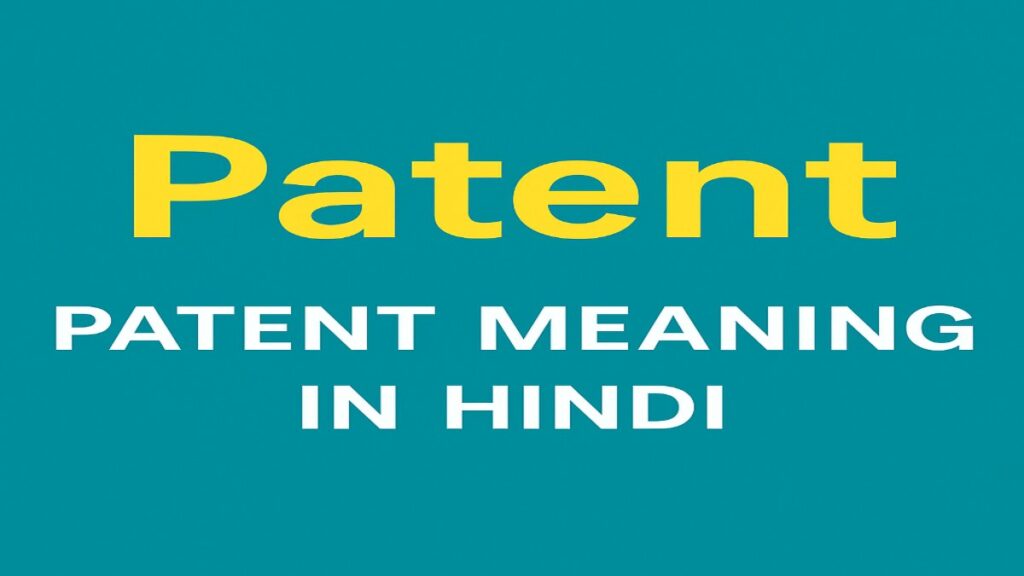Introduction to Patent
Patent Meaning in Hindi. Patents are everywhere from your smartphone to that fancy coffee machine in your kitchen. But what exactly is a patent, and why is it such a big deal?
What is a Patent?
A patent is a legal right granted to an inventor that gives them the exclusive power to make, use, sell, or license their invention for a specific period. Think of it as a “No Trespassing” sign for your unique idea.
Why Patents Matter?
Without patents, innovation would stall. Why would someone spend years creating something amazing if someone else could just steal the idea?
🧪 Types of Patents
There’s more than one kind of patent. Depending on your invention, you might need a different type:
Utility Patent
For machines, processes, or new inventions that are useful.
Design Patent
Protects the look or aesthetic design of a product.
Plant Patent
Yes, even plants get patents! If you invent or discover a new plant variety, you can patent it.
🎯 Purpose and Importance of Patents
Innovation Protection
Patents encourage innovation by protecting ideas.
Legal Rights
No one can legally copy, manufacture, or sell your invention.
Commercial Benefits
You can monetize your patent through licensing or selling.
📝 How to Apply for a Patent in India
Eligibility Criteria
Not every idea can be patented. It must be:
- Novel
- Non-obvious
- Useful
Application Process
- Draft patent specification
- File application with the Indian Patent Office
- Request examination
- Respond to objections (if any)
- Grant of patent
Time and Cost
It usually takes 2–3 years and can cost anywhere from ₹10,000 to ₹1,00,000 depending on the complexity.
🔑 Common Terms Related to Patent
Patent Infringement
When someone uses your patented idea without permission.
Intellectual Property (IP)
A broader category that includes patents, copyrights, and trademarks.
Trademark vs. Patent
Trademarks protect brand names, patents protect inventions.
📜 Patent Laws in India
The Patents Act, 1970
India’s main patent law that governs everything about patents.
Amendments and Reforms
The law has been updated several times to align with global standards.
🌍 Global Patent Systems
USPTO
United States Patent and Trademark Office.
EPO
European Patent Office.
WIPO
World Intellectual Property Organization—helps with international filings.
🚀 Benefits of Having a Patent
Monopoly Rights
You’re the only one who can commercially use your invention.
Market Advantage
Patents can block competitors from copying your idea.
Investment Opportunities
Investors love innovative and protected ideas.
⚠️ Challenges in Patent Filing
Complex Documentation
Patent applications are detailed and require technical skill.
Rejections and Appeals
Many patents are rejected on the first try. Appeals can take time.
Maintenance Fees
Even after approval, you need to pay to keep the patent alive.
💼 Patent Examples
Everyday Inventions
- Ballpoint pen
- Washing machine
- Mobile phone camera
Famous Patent Holders
- Thomas Edison (light bulb)
- Steve Jobs (iPhone design)
- Elon Musk (Tesla technology)
🆚 Patent vs Copyright vs Trademark
Key Differences
| Feature | Patent | Copyright | Trademark |
|---|---|---|---|
| Protects | Invention | Creative Work | Brand/Logo |
| Validity | 20 Years (mostly) | Author’s life + 60Y | Renewable |
🎓 Career in Patent Industry
Patent Agents and Attorneys
These are professionals who help file and manage patents.
Qualifications Needed
A science or engineering degree + passing the Indian Patent Agent exam.
✅ Conclusion
Understanding the concept of a patent—especially in your own language empowers you to innovate and protect. Whether you’re an entrepreneur, student, or a curious mind, knowing the meaning of patent in Hindi gives you a solid foundation in the world of intellectual property.
❓ FAQs
Q1. पेटेंट करवाने में कितना खर्च आता है?
A1. सामान्यत: ₹10,000 से लेकर ₹1,00,000 तक का खर्च हो सकता है।
Q2. क्या मैं खुद से पेटेंट फाइल कर सकता हूँ?
A2. हाँ, लेकिन विशेषज्ञ की मदद लेना बेहतर होता है।
Q3. पेटेंट कितने समय के लिए वैध होता है?
A3. आमतौर पर 20 वर्षों के लिए।
Q4. क्या पेटेंट अंतरराष्ट्रीय होता है?
A4. नहीं, पर आप WIPO के ज़रिए इंटरनेशनल पेटेंट ले सकते हैं।
Q5. क्या हर डिज़ाइन पेटेंट हो सकता है?
A5. नहीं, डिज़ाइन नया और यूनिक होना चाहिए।







